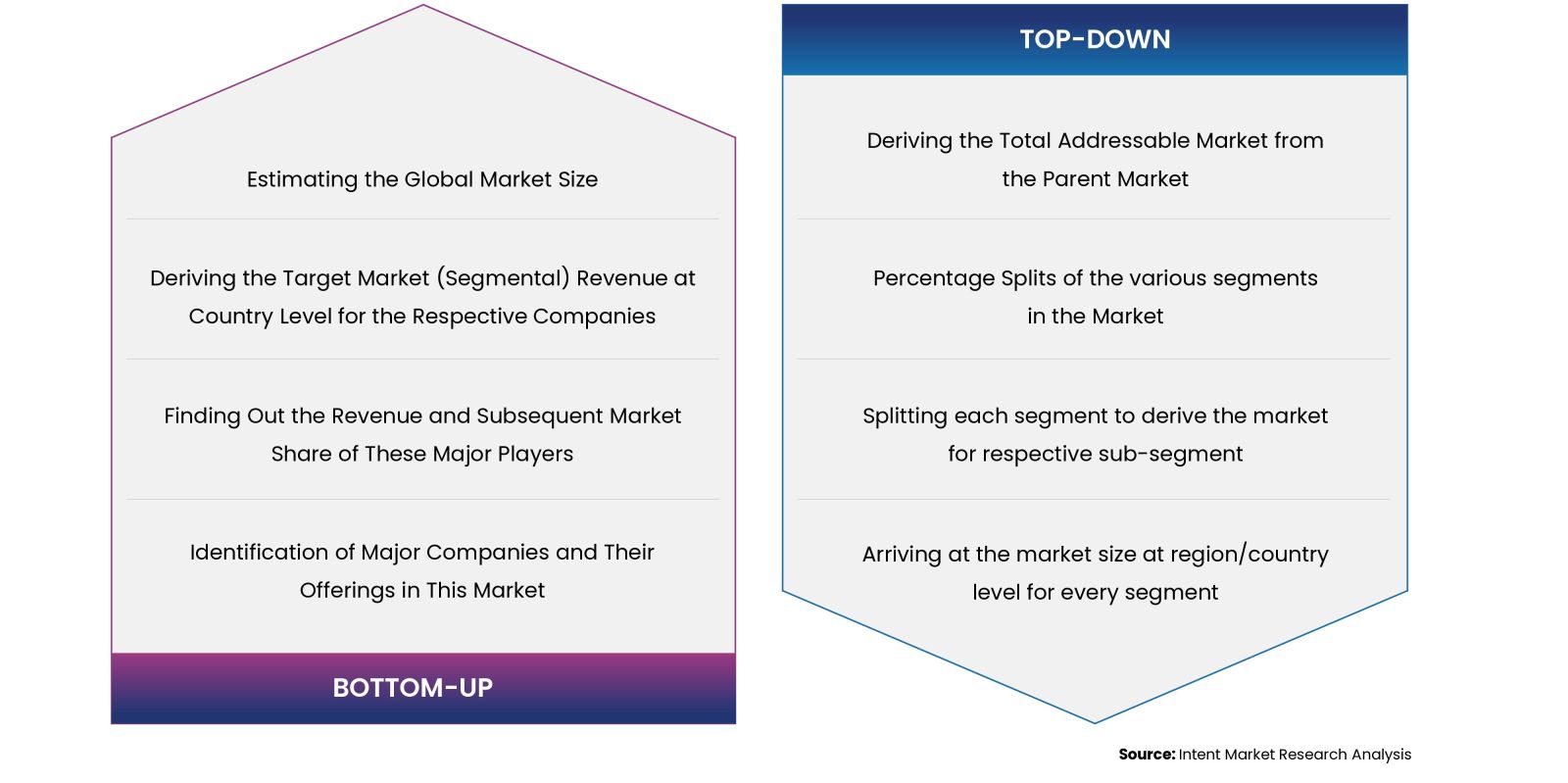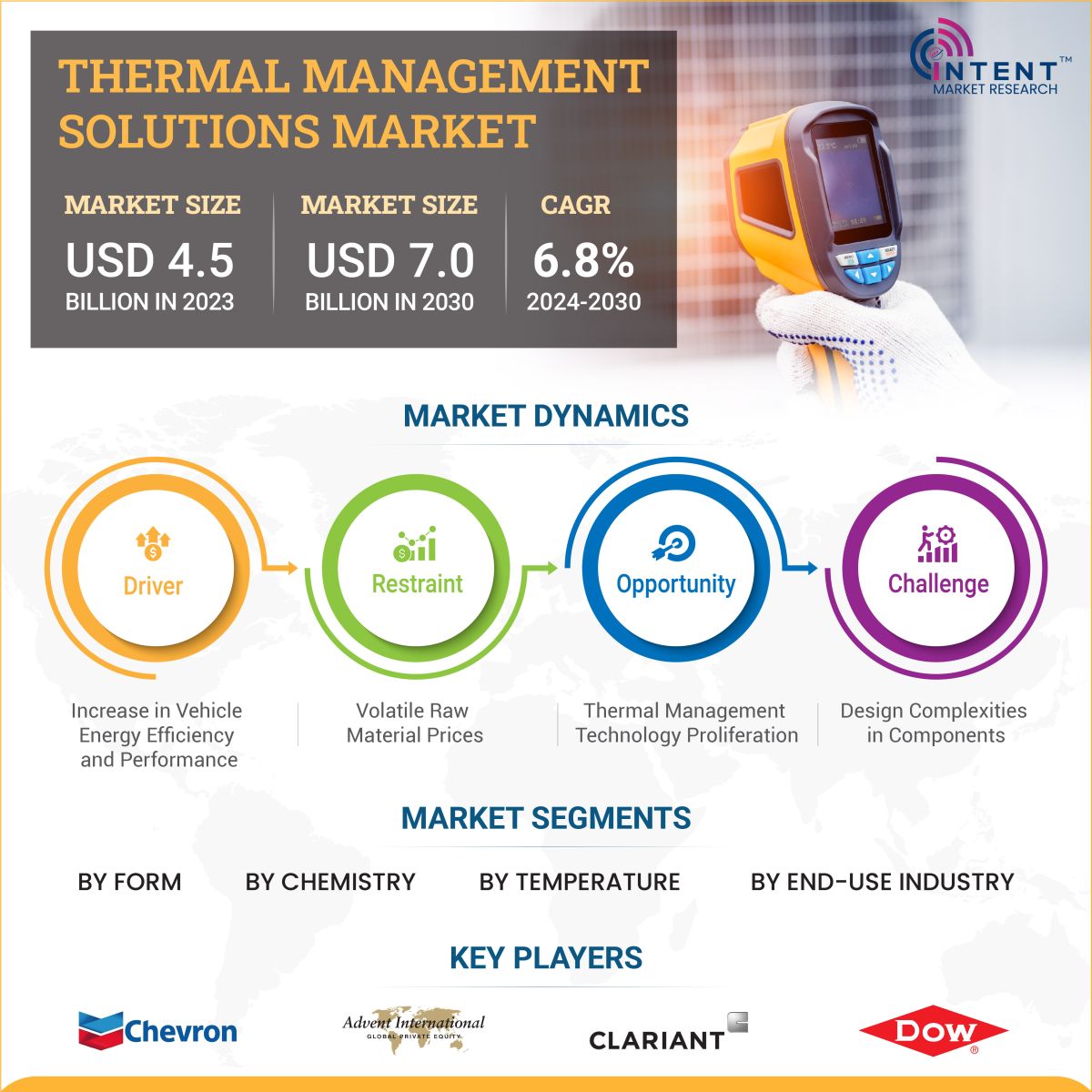According to Intent Market Research, the Thermal Management Solutions Market is expected to grow from USD 4.5 billion in 2023-e at a CAGR of 6.8% to touch USD 7.0 billion by 2030. Some of the companies operating in this market include Advent International, Chevron, Clariant, Dow, Eastman Chemicals, ExxonMobil, Hexcel, Huntsman, Lanxess, 3M, Momentive Performance Materials, Parker Hannifin, Shell, Shin-Etsu Chemical, and Wacker. Electronics industry growth and increasing need for thermal management solutions in the industry across the globe is driving the thermal management solutions market.
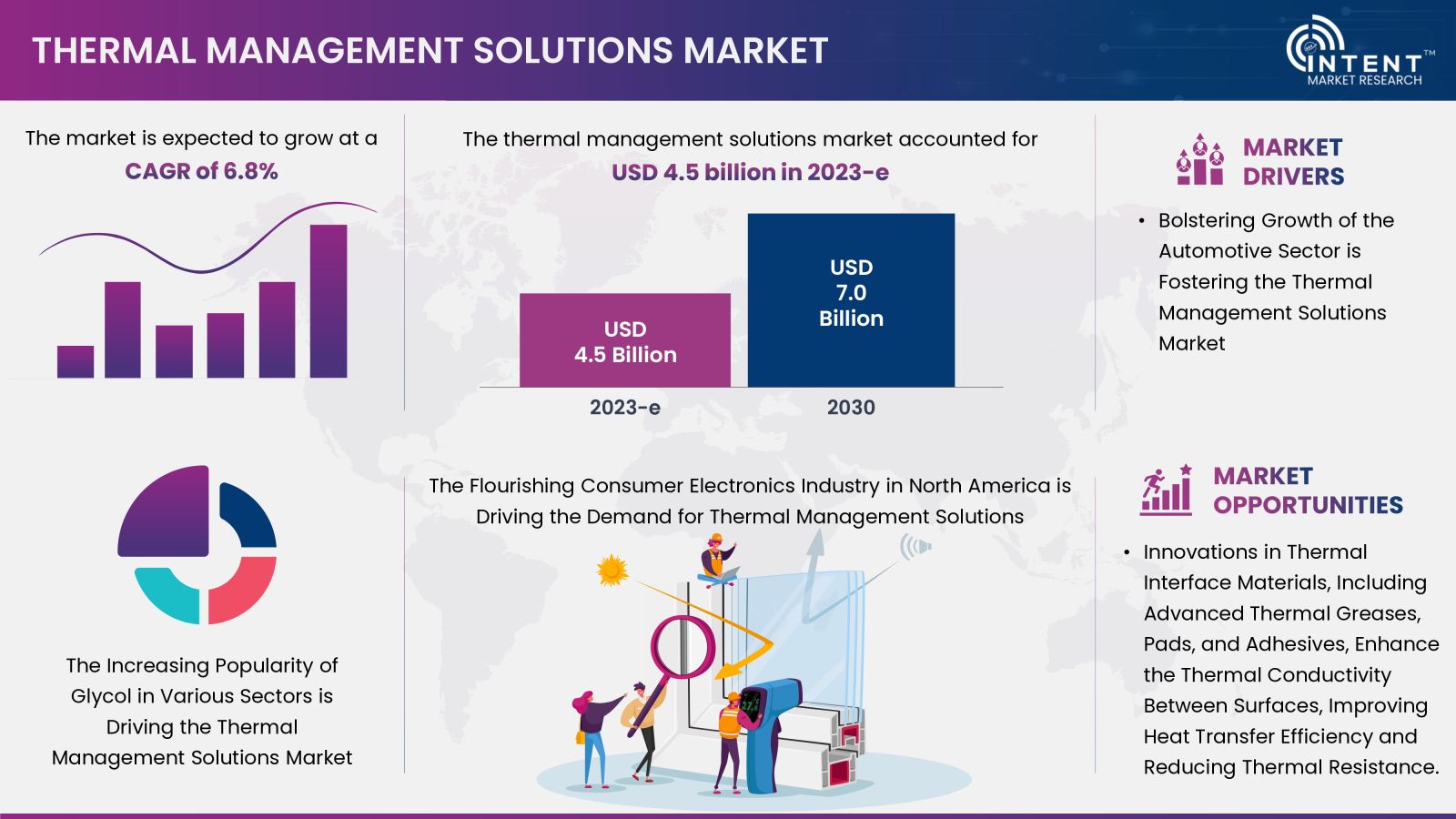
Click here to: Get FREE Sample Pages of this Report
Thermal management solution controls and regulates heat in electronic devices and systems to maintain optimal operating temperatures. This is extremely important to ensure component reliability, performance, and longevity. With increasing power density and miniaturization, thermal management becomes important to prevent overheating, reduce energy consumption, and improve system efficiency. Thermal management solutions prevents heat-related failures and ensure safe and reliable electronic equipment operation in various applications.
Thermal Management Solutions Market Dynamics
Automotive Industry Growth is Fostering the Thermal Management Solutions Market
Thermal management solutions are increasingly used in automotive industry due to the complexity of automotive systems, the need for enhanced fuel efficiency, and the popularity of electric vehicles. Advanced thermal management is necessary to regulate temperatures and ensure optimal efficiency in powertrain systems, sensors, processors, and communication systems. Technological advancements, including advanced materials, smart sensors, and predictive analytics in automotive industry are contributing to the market growth.
Design Complexities of Components Utilized in Cooling Systems are Hampering the Market Growth
The global thermal management market faces design complexities in components used in cooling systems, leading to higher costs, longer development cycles, and potential performance limitations. Effective cooling components require expertise in thermal engineering, material science, and manufacturing processes. These intricate design requirements and associated costs can also limit innovation in new thermal management solutions, making it difficult for companies to develop and commercialize advanced cooling technologies.
Thermal Management Solutions Market Segment Insights
The Increasing Popularity of Glycol in Various Sectors is Driving the Thermal Management Solutions Market
Glycol, particularly ethylene and propylene glycol, is a popular heat transfer fluid due to its high thermal conductivity. It is used in various industries for efficient heat dissipation and temperature regulation, such as in automotive radiators, HVAC systems, solar thermal systems, data centers, and electronic devices. Glycol-based fluids are also commonly used in industrial processes for precise temperature control and in winterization applications. The development of bio-based glycols aligns with sustainability goals and reduces the risk of corrosion in the systems they are used. Glycol's versatility and effectiveness in thermal management applications are driving its demand and the overall market growth.
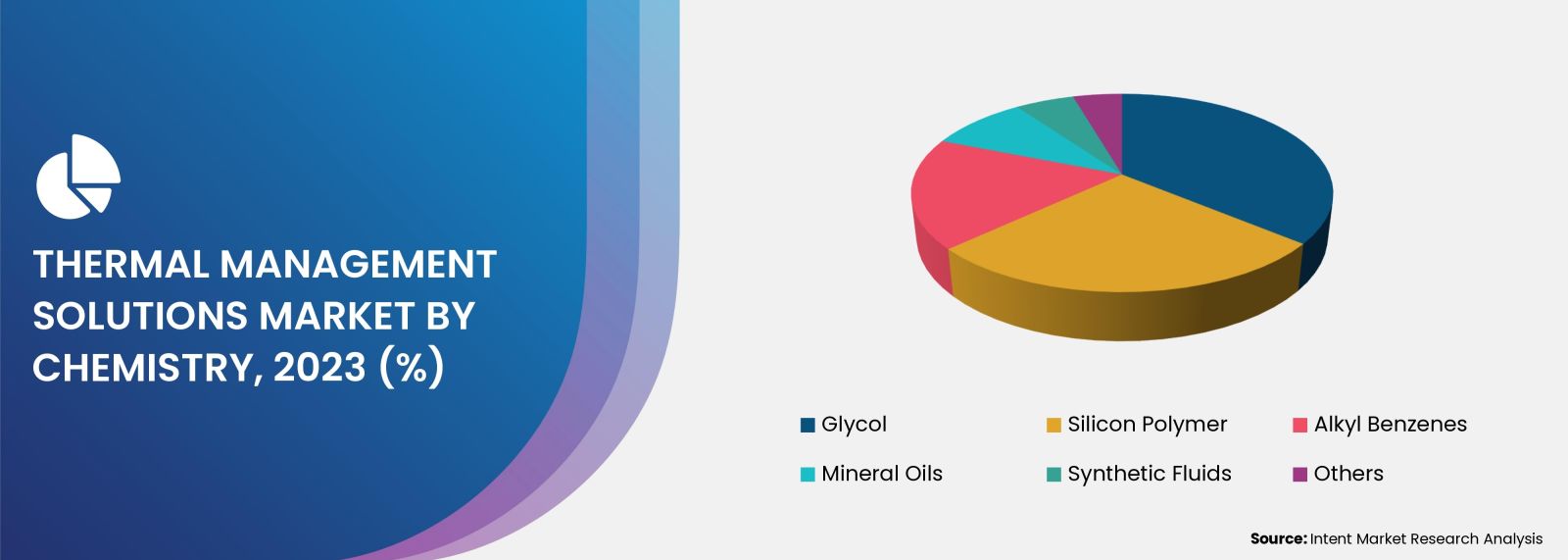
Favorable Properties of Non-aqueous Solutions offers Significant MGrowth Opportunities
Non-aqueous fluids are preferred for high-temperature applications as they retain stability over a broader temperature range without freezing or boiling. They also cause less corrosion in metal components and are used with a wide range of materials. They are highly suitable for electrical and electronic applications and exhibit high chemical stability. Non-aqueous fluids have lower vapor pressure, higher thermal conductivity, and lower biological growth, making them advantageous for various thermal management applications.
Demand for High-Temperature Thermal Management Solutions is Thriving Due to Optimal Performance and Reliability
Electronic devices generate significant heat during operation, requiring high-temperature stability thermal management solutions to ensure optimal performance and reliability. Harsh operating conditions in aerospace & defense applications necessitate thermal management solutions capable of withstanding elevated temperatures. The automotive and solar industries also rely on high-temperature thermal management solutions to cool powertrain systems and optimize the efficiency of solar collectors. The materials and formulations of these solutions are engineered to withstand extreme thermal conditions.
Increasing Adoption of Thermal Management Solutions in Energy and Power is Boosting the Market Growth
Renewable energy sources such as solar and wind power require thermal management solutions to maintain optimal operating temperatures in solar panels, wind turbines, and power electronics, including inverters. Thermal management solutions are also essential for energy storage systems, electric vehicles, nuclear power plants, cogeneration and CHP systems, geothermal power plants, and hydropower systems. The integration of thermal management solutions in the energy and power sector is driven by the need to enhance system reliability, optimize energy production and storage, to meet the increasing demand for sustainable and efficient power generation.
Regional Insights
The Flourishing Consumer Electronics Industry in North America is Driving the Demand for Thermal Management Solutions
The US consumer technology industry is expected to achieve record-breaking retail sales revenue of over USD 505 billion, driven by increasing demand for smartphones, health devices, streaming services, and automotive tech. The transition to electrification in the automotive industry is also contributing to the market's growth. Thermal management in EVs powered by batteries is crucial for their performance and reliability. EV sales increased by 85% and plug-in hybrid electric vehicles (PHEVs) by 138% in 2021 compared to the previous year.
Competitive Landscape
Novel Product Launches are the Major Strategy Adopted by the Key Players
The thermal management technologies market is highly fragmented with growing competition. In January 2022, Parker Lord expanded its product portfolio for electric vehicle manufacturers, adding new thermally conductive adhesives and 1K low-density gap fillers. Some of the companies operating in this market include Advent International, Chevron, Clariant, Dow, Eastman Chemicals, ExxonMobil, Hexcel, Huntsman, Lanxess, 3M, Momentive Performance Materials, Parker Hannifin, Shell, Shin-Etsu Chemical, and Wacker.
Click here to: Get your custom research report today
Thermal Management Solutions Market Coverage
The report provides key insights into the thermal management solutions market, and it focuses on technological developments, trends, and initiatives taken by the government. In this sector, the analysis delves into market drivers, restraints, opportunities, and other pertinent factors. The report also scrutinizes key players and the competitive landscape in the thermal management solutions market.

Report Scope
|
Report Features |
Description |
|
Market Size (2023-e) |
USD 4.5 billion |
|
Forecast Revenue (2030) |
USD 7.0 billion |
|
CAGR (2024-2030) |
6.8% |
|
Base Year for Estimation |
2023-e |
|
Historic Year |
2022 |
|
Forecast Period |
2024-2030 |
|
Report Coverage |
Revenue Forecast, Market Dynamics, Competitive Landscape, Recent Developments |
|
Segments Covered |
By Form (Aqueous, Non-Aqueous and Gaseous), By Chemistry (Alkyl Benzenes, Mineral Oils, Synthetic Fluids, Silicon Polymer, Glycol, Others), By Temperature (Low-Temperature Thermal Management (Below 0°C to 100°C), Moderate-Temperature Thermal Management (100°C to 300°C), High-Temperature Thermal Management (300°C to 800°C)), By End-Use Industry (IT & Telecommunications, Consumer Electronics, Automotive, Aerospace & Defense, Healthcare, Power & Energy, Others) |
|
Regional Analysis |
North America (US, Canada), Europe (Germany, France, UK, Italy), Asia-Pacific (China, Japan, South Korea, India), Latin America (Brazil, Mexico, Argentina), Middle East and Africa (Saudi Arabia, South Africa, United Arab Emirates) |
|
Competitive Landscape |
Advent International, Chevron, Clariant, Dow, Eastman Chemicals, ExxonMobil, Hexcel, Huntsman, Lanxess, 3M, Momentive Performance Materials, Parker Hannifin, Shell, Shin-Etsu Chemical and Wacker |
|
Customization Scope |
Customization for segments, region/country-level will be provided. Moreover, additional customization can be done based on the requirements. |
|
Purchase Options |
We have three licenses to opt for Single User License, Multi-User License (Up to 5 Users), Corporate Use License (Unlimited User and Printable PDF) |
|
1. Introduction |
|
1. 1. Study Assumptions and Thermal Management Solutions Market Definition |
|
1.2. Scope of the Study |
|
2. Research Methodology |
|
3. Executive Summary |
|
4. Thermal Management Solutions Market Dynamics |
|
4.1. Market Growth Drivers |
|
4.2 Market Growth Challenges |
|
5. Thermal Management Solutions Market Outlook |
|
5.1. Investment Analysis |
|
5.2.Technological Developments |
|
5.3.Case Study |
|
5.4.Regulatory Framework |
|
5.5.Industry Value Chain Analysis |
|
5.6.Porter's Five Forces analysis |
|
5.7.Pricing Analysis |
|
5.8.Patent Analysis |
|
6. Global Thermal Management Solutions Market Segmentation (Market Size & Forecast: USD Billion, 2024 – 2030) |
|
6.1 Form |
|
6.1.1 Aqueous |
|
6.1.2 Non-Aqueous |
|
6.1.3 Gaseous |
|
6.2 Chemistry |
|
6.2.1 Alkyl Benzenes |
|
6.2.2 Mineral Oils |
|
6.2.3 Synthetic Fluids |
|
6.2.4 Silicon Polymer |
|
6.2.5 Glycol |
|
6.2.6 Others |
|
6.3 Temperature |
|
6.3.1 Low-Temperature Thermal Management (Below 0°C to 100°C) |
|
6.3.2 Moderate-Temperature Thermal Management (100°C to 300°C) |
|
6.3.3 High-Temperature Thermal Management (300°C to 800°C) |
|
6.4 End-Use Industry |
|
6.4.1 IT & Telecommunications |
|
6.4.2 Consumer Electronics |
|
6.4.3 Automotive |
|
6.4.4 Aerospace & Defense |
|
6.4.5 Healthcare |
|
6.4.6 Power & Energy |
|
6.4.7 Others |
|
6.5 Geography |
|
6.5.1 North America |
|
6.5.2 Europe |
|
6.5.3 Asia-Pacific |
|
6.5.4 Latin America |
|
6.5.5 Middle East and Africa |
|
7. North America Thermal Management Solutions Market Segmentation (Market Size & Forecast: USD Billion, 2024 – 2030) |
|
7.1 Form |
|
7.1.1 Aqueous |
|
7.1.2 Non-Aqueous |
|
7.1.3 Gaseous |
|
7.2 Chemistry |
|
7.2.1 Alkyl Benzenes |
|
7.2.2 Mineral Oils |
|
7.2.3 Synthetic Fluids |
|
7.2.4 Silicon Polymer |
|
7.2.5 Glycol |
|
7.2.7 Others |
|
7.3 Temperature |
|
7.3.1 Low-Temperature Thermal Management (Below 0°C to 100°C) |
|
7.3.2 Moderate-Temperature Thermal Management (100°C to 300°C) |
|
7.3.3 High-Temperature Thermal Management (300°C to 800°C) |
|
7.4 End-Use Industry |
|
7.4.1 IT and Telecommunications |
|
7.4.2 Consumer Electronics |
|
7.4.3 Automotive |
|
7.4.4 Aerospace and Defense |
|
7.4.5 Healthcare |
|
7.4.7 Power & Energy |
|
7.4.7 Others |
|
7.5 Country |
|
7.5.1 United States |
|
7.5.1.1 Form |
|
7.5.1.1.1 Aqueous |
|
7.5.1.1.2 Non-Aqueous |
|
7.5.1.1.3 Gaseous |
|
7.5.1.2 Chemistry |
|
7.5.1.2.1 Alkyl Benzenes |
|
7.5.1.2.2 Mineral Oils |
|
7.5.1.2.3 Synthetic Fluids |
|
7.5.1.2.4 Silicon Polymer |
|
7.5.1.2.5 Glycol |
|
7.5.1.2.6 Others |
|
7.5.1.3 Temperature |
|
7.5.1.3.1 Low-Temperature Thermal Management (Below 0°C to 100°C) |
|
7.5.1.3.2 Moderate-Temperature Thermal Management (100°C to 300°C) |
|
7.5.1.3.3 High-Temperature Thermal Management (300°C to 800°C) |
|
7.5.1.4 End-Use Industry |
|
7.5.1.4.1 IT and Telecommunications |
|
7.5.1.4.2 Consumer Electronics |
|
7.5.1.4.3 Automotive |
|
7.5.1.4.4 Aerospace and Defense |
|
7.5.1.4.5 Healthcare |
|
7.5.1.4.5 Power & Energy |
|
7.5.1.4.6 Others |
|
7.5.2 Canada |
|
7.5.2.1 Form |
|
7.5.2.1.1 Aqueous |
|
7.5.2.1.2 Non-Aqueous |
|
7.5.2.1.3 Gaseous |
|
7.5.2.2 Chemistry |
|
7.5.2.2.1 Alkyl Benzenes |
|
7.5.2.2.2 Mineral Oils |
|
7.5.2.2.3 Synthetic Fluids |
|
7.5.2.2.4 Silicon Polymer |
|
7.5.2.2.5 Glycol |
|
7.5.2.2.6 Others |
|
7.5.2.3 Temperature |
|
7.5.2.3.1 Low-Temperature Thermal Management (Below 0°C to 100°C) |
|
7.5.2.3.2 Moderate-Temperature Thermal Management (100°C to 300°C) |
|
7.5.2.3.3 High-Temperature Thermal Management (300°C to 800°C) |
|
7.5.2.4 End-Use Industry |
|
7.5.2.4.1 IT and Telecommunications |
|
7.5.2.4.2 Consumer Electronics |
|
7.5.2.4.3 Automotive |
|
7.5.2.4.4 Aerospace and Defense |
|
7.5.2.4.5 Healthcare |
|
7.5.2.4.6 Power & Energy |
|
7.5.2.4.7 Others |
|
8. Europe Market Thermal Management Solutions Segmentation (Market Size & Forecast: USD Billion, 2024 – 2030) |
|
8.1 Form |
|
8.1.1 Aqueous |
|
8.1.2 Non-Aqueous |
|
8.1.3 Gaseous |
|
8.2 Chemistry |
|
8.2.1 Alkyl Benzenes |
|
8.2.2 Mineral Oils |
|
8.2.3 Synthetic Fluids |
|
8.2.4 Silicon Polymer |
|
8.2.5 Glycol |
|
8.2.8 Others |
|
8.3 Temperature |
|
8.3.1 Low-Temperature Thermal Management (Below 0°C to 100°C) |
|
8.3.2 Moderate-Temperature Thermal Management (100°C to 300°C) |
|
8.3.3 High-Temperature Thermal Management (300°C to 800°C) |
|
8.4 End-Use Industry |
|
8.4.1 IT and Telecommunications |
|
8.4.2 Consumer Electronics |
|
8.4.3 Automotive |
|
8.4.4 Aerospace and Defense |
|
8.4.5 Healthcare |
|
8.4.8 Power & Energy |
|
8.4.8 Others |
|
8.5 Country |
|
8.5.1 Germany |
|
8.5.1.1 Form |
|
8.5.1.1.1 Aqueous |
|
8.5.1.1.2 Non-Aqueous |
|
8.5.1.1.3 Gaseous |
|
8.5.1.2 Chemistry |
|
8.5.1.2.1 Alkyl Benzenes |
|
8.5.1.2.2 Mineral Oils |
|
8.5.1.2.3 Synthetic Fluids |
|
8.5.1.2.4 Silicon Polymer |
|
8.5.1.2.5 Glycol |
|
8.5.1.2.6 Others |
|
8.5.1.3 Temperature |
|
8.5.1.3.1 Low-Temperature Thermal Management (Below 0°C to 100°C) |
|
8.5.1.3.2 Moderate-Temperature Thermal Management (100°C to 300°C) |
|
8.5.1.3.3 High-Temperature Thermal Management (300°C to 800°C) |
|
8.5.1.4 End-Use Industry |
|
8.5.1.4.1 IT and Telecommunications |
|
8.5.1.4.2 Consumer Electronics |
|
8.5.1.4.3 Automotive |
|
8.5.1.4.4 Aerospace and Defense |
|
8.5.1.4.5 Healthcare |
|
8.5.1.4.5 Power & Energy |
|
8.5.1.4.6 Others |
|
8.5.2 France |
|
8.5.2.1 Form |
|
8.5.2.1.1 Aqueous |
|
8.5.2.1.2 Non-Aqueous |
|
8.5.2.1.3 Gaseous |
|
8.5.2.2 Chemistry |
|
8.5.2.2.1 Alkyl Benzenes |
|
8.5.2.2.2 Mineral Oils |
|
8.5.2.2.3 Synthetic Fluids |
|
8.5.2.2.4 Silicon Polymer |
|
8.5.2.2.5 Glycol |
|
8.5.2.2.6 Others |
|
8.5.2.3 Temperature |
|
8.5.2.3.1 Low-Temperature Thermal Management (Below 0°C to 100°C) |
|
8.5.2.3.2 Moderate-Temperature Thermal Management (100°C to 300°C) |
|
8.5.2.3.3 High-Temperature Thermal Management (300°C to 800°C) |
|
8.5.2.4 End-Use Industry |
|
8.5.2.4.1 IT and Telecommunications |
|
8.5.2.4.2 Consumer Electronics |
|
8.5.2.4.3 Automotive |
|
8.5.2.4.4 Aerospace and Defense |
|
8.5.2.4.5 Healthcare |
|
8.5.2.4.6 Power & Energy |
|
8.5.2.4.7 Others |
|
8.5.3 United Kingdom |
|
8.5.3.1 Form |
|
8.5.3.1.1 Aqueous |
|
8.5.3.1.2 Non-Aqueous |
|
8.5.3.1.3 Gaseous |
|
8.5.3.2 Chemistry |
|
8.5.3.2.1 Alkyl Benzenes |
|
8.5.3.2.2 Mineral Oils |
|
8.5.3.2.3 Synthetic Fluids |
|
8.5.3.2.4 Silicon Polymer |
|
8.5.3.2.5 Glycol |
|
8.5.3.2.6 Others |
|
8.5.3.3 Temperature |
|
8.5.3.3.1 Low-Temperature Thermal Management (Below 0°C to 100°C) |
|
8.5.3.3.2 Moderate-Temperature Thermal Management (100°C to 300°C) |
|
8.5.3.3.3 High-Temperature Thermal Management (300°C to 800°C) |
|
8.5.3.4 End-Use Industry |
|
8.5.3.4.1 IT and Telecommunications |
|
8.5.3.4.2 Consumer Electronics |
|
8.5.3.4.3 Automotive |
|
8.5.3.4.4 Aerospace and Defense |
|
8.5.3.4.5 Healthcare |
|
8.5.3.4.5 Power & Energy |
|
8.5.3.4.6 Others |
|
8.5.4 Italy |
|
8.5.4.1 Form |
|
8.5.4.1.1 Aqueous |
|
8.5.4.1.2 Non-Aqueous |
|
8.5.4.1.3 Gaseous |
|
8.5.4.2 Chemistry |
|
8.5.4.2.1 Alkyl Benzenes |
|
8.5.4.2.2 Mineral Oils |
|
8.5.4.2.3 Synthetic Fluids |
|
8.5.4.2.4 Silicon Polymer |
|
8.5.4.2.5 Glycol |
|
8.5.4.2.6 Others |
|
8.5.4.3 Temperature |
|
8.5.4.3.1 Low-Temperature Thermal Management (Below 0°C to 100°C) |
|
8.5.4.3.2 Moderate-Temperature Thermal Management (100°C to 300°C) |
|
8.5.4.3.3 High-Temperature Thermal Management (300°C to 800°C) |
|
8.5.4.4 End-Use Industry |
|
8.5.4.4.1 IT and Telecommunications |
|
8.5.4.4.2 Consumer Electronics |
|
8.5.4.4.3 Automotive |
|
8.5.4.4.4 Aerospace and Defense |
|
8.5.4.4.5 Healthcare |
|
8.5.4.4.6 Power & Energy |
|
8.5.4.4.7 Others |
|
9. Asia-Pacific Thermal Management Solutions Market Segmentation (Market Size & Forecast: USD Billion, 2024 – 2030) |
|
9.1 Form |
|
9.1.1 Aqueous |
|
9.1.2 Non-Aqueous |
|
9.1.3 Gaseous |
|
9.2 Chemistry |
|
9.2.1 Alkyl Benzenes |
|
9.2.2 Mineral Oils |
|
9.2.3 Synthetic Fluids |
|
9.2.4 Silicon Polymer |
|
9.2.5 Glycol |
|
9.2.9 Others |
|
9.3 Temperature |
|
9.3.1 Low-Temperature Thermal Management (Below 0°C to 100°C) |
|
9.3.2 Moderate-Temperature Thermal Management (100°C to 300°C) |
|
9.3.3 High-Temperature Thermal Management (300°C to 900°C) |
|
9.4 End-Use Industry |
|
9.4.1 IT and Telecommunications |
|
9.4.2 Consumer Electronics |
|
9.4.3 Automotive |
|
9.4.4 Aerospace and Defense |
|
9.4.5 Healthcare |
|
9.4.9 Power & Energy |
|
9.4.9 Others |
|
9.5 Country |
|
9.5.1 Japan |
|
9.5.1.1 Form |
|
9.5.1.1.1 Aqueous |
|
9.5.1.1.2 Non-Aqueous |
|
9.5.1.1.3 Gaseous |
|
9.5.1.2 Chemistry |
|
9.5.1.2.1 Alkyl Benzenes |
|
9.5.1.2.2 Mineral Oils |
|
9.5.1.2.3 Synthetic Fluids |
|
9.5.1.2.4 Silicon Polymer |
|
9.5.1.2.5 Glycol |
|
9.5.1.2.6 Others |
|
9.5.1.3 Temperature |
|
9.5.1.3.1 Low-Temperature Thermal Management (Below 0°C to 100°C) |
|
9.5.1.3.2 Moderate-Temperature Thermal Management (100°C to 300°C) |
|
9.5.1.3.3 High-Temperature Thermal Management (300°C to 900°C) |
|
9.5.1.4 End-Use Industry |
|
9.5.1.4.1 IT and Telecommunications |
|
9.5.1.4.2 Consumer Electronics |
|
9.5.1.4.3 Automotive |
|
9.5.1.4.4 Aerospace and Defense |
|
9.5.1.4.5 Healthcare |
|
9.5.1.4.5 Power & Energy |
|
9.5.1.4.6 Others |
|
9.5.2 China |
|
9.5.2.1 Form |
|
9.5.2.1.1 Aqueous |
|
9.5.2.1.2 Non-Aqueous |
|
9.5.2.1.3 Gaseous |
|
9.5.2.2 Chemistry |
|
9.5.2.2.1 Alkyl Benzenes |
|
9.5.2.2.2 Mineral Oils |
|
9.5.2.2.3 Synthetic Fluids |
|
9.5.2.2.4 Silicon Polymer |
|
9.5.2.2.5 Glycol |
|
9.5.2.2.6 Others |
|
9.5.2.3 Temperature |
|
9.5.2.3.1 Low-Temperature Thermal Management (Below 0°C to 100°C) |
|
9.5.2.3.2 Moderate-Temperature Thermal Management (100°C to 300°C) |
|
9.5.2.3.3 High-Temperature Thermal Management (300°C to 900°C) |
|
9.5.2.4 End-Use Industry |
|
9.5.2.4.1 IT and Telecommunications |
|
9.5.2.4.2 Consumer Electronics |
|
9.5.2.4.3 Automotive |
|
9.5.2.4.4 Aerospace and Defense |
|
9.5.2.4.5 Healthcare |
|
9.5.2.4.6 Power & Energy |
|
9.5.2.4.7 Others |
|
9.5.3 India |
|
9.5.3.1 Form |
|
9.5.3.1.1 Aqueous |
|
9.5.3.1.2 Non-Aqueous |
|
9.5.3.1.3 Gaseous |
|
9.5.3.2 Chemistry |
|
9.5.3.2.1 Alkyl Benzenes |
|
9.5.3.2.2 Mineral Oils |
|
9.5.3.2.3 Synthetic Fluids |
|
9.5.3.2.4 Silicon Polymer |
|
9.5.3.2.5 Glycol |
|
9.5.3.2.6 Others |
|
9.5.3.3 Temperature |
|
9.5.3.3.1 Low-Temperature Thermal Management (Below 0°C to 100°C) |
|
9.5.3.3.2 Moderate-Temperature Thermal Management (100°C to 300°C) |
|
9.5.3.3.3 High-Temperature Thermal Management (300°C to 900°C) |
|
9.5.3.4 End-Use Industry |
|
9.5.3.4.1 IT and Telecommunications |
|
9.5.3.4.2 Consumer Electronics |
|
9.5.3.4.3 Automotive |
|
9.5.3.4.4 Aerospace and Defense |
|
9.5.3.4.5 Healthcare |
|
9.5.3.4.5 Power & Energy |
|
9.5.3.4.6 Others |
|
9.5.4 South Korea |
|
9.5.4.1 Form |
|
9.5.4.1.1 Aqueous |
|
9.5.4.1.2 Non-Aqueous |
|
9.5.4.1.3 Gaseous |
|
9.5.4.2 Chemistry |
|
9.5.4.2.1 Alkyl Benzenes |
|
9.5.4.2.2 Mineral Oils |
|
9.5.4.2.3 Synthetic Fluids |
|
9.5.4.2.4 Silicon Polymer |
|
9.5.4.2.5 Glycol |
|
9.5.4.2.6 Others |
|
9.5.4.3 Temperature |
|
9.5.4.3.1 Low-Temperature Thermal Management (Below 0°C to 100°C) |
|
9.5.4.3.2 Moderate-Temperature Thermal Management (100°C to 300°C) |
|
9.5.4.3.3 High-Temperature Thermal Management (300°C to 900°C) |
|
9.5.4.4 End-Use Industry |
|
9.5.4.4.1 IT and Telecommunications |
|
9.5.4.4.2 Consumer Electronics |
|
9.5.4.4.3 Automotive |
|
9.5.4.4.4 Aerospace and Defense |
|
9.5.4.4.5 Healthcare |
|
9.5.4.4.6 Power & Energy |
|
9.5.4.4.7 Others |
|
10. Latin America Thermal Management Solutions Market Segmentation (Market Size & Forecast: USD Billion, 2024 – 2030) |
|
10.1 Form |
|
10.1.1 Aqueous |
|
10.1.2 Non-Aqueous |
|
10.1.3 Gaseous |
|
10.2 Chemistry |
|
10.2.1 Alkyl Benzenes |
|
10.2.2 Mineral Oils |
|
10.2.3 Synthetic Fluids |
|
10.2.4 Silicon Polymer |
|
10.2.5 Glycol |
|
10.2.10 Others |
|
10.3 Temperature |
|
10.3.1 Low-Temperature Thermal Management (Below 0°C to 100°C) |
|
10.3.2 Moderate-Temperature Thermal Management (100°C to 300°C) |
|
10.3.3 High-Temperature Thermal Management (300°C to 1000°C) |
|
10.4 End-Use Industry |
|
10.4.1 IT and Telecommunications |
|
10.4.2 Consumer Electronics |
|
10.4.3 Automotive |
|
10.4.4 Aerospace and Defense |
|
10.4.5 Healthcare |
|
10.4.10 Power & Energy |
|
10.4.10 Others |
|
10.5 Country |
|
10.5.1 Brazil |
|
10.5.1.1 Form |
|
10.5.1.1.1 Aqueous |
|
10.5.1.1.2 Non-Aqueous |
|
10.5.1.1.3 Gaseous |
|
10.5.1.2 Chemistry |
|
10.5.1.2.1 Alkyl Benzenes |
|
10.5.1.2.2 Mineral Oils |
|
10.5.1.2.3 Synthetic Fluids |
|
10.5.1.2.4 Silicon Polymer |
|
10.5.1.2.5 Glycol |
|
10.5.1.2.6 Others |
|
10.5.1.3 Temperature |
|
10.5.1.3.1 Low-Temperature Thermal Management (Below 0°C to 100°C) |
|
10.5.1.3.2 Moderate-Temperature Thermal Management (100°C to 300°C) |
|
10.5.1.3.3 High-Temperature Thermal Management (300°C to 1000°C) |
|
10.5.1.4 End-Use Industry |
|
10.5.1.4.1 IT and Telecommunications |
|
10.5.1.4.2 Consumer Electronics |
|
10.5.1.4.3 Automotive |
|
10.5.1.4.4 Aerospace and Defense |
|
10.5.1.4.5 Healthcare |
|
10.5.1.4.5 Power & Energy |
|
10.5.1.4.6 Others |
|
10.5.2 Mexico |
|
10.5.2.1 Form |
|
10.5.2.1.1 Aqueous |
|
10.5.2.1.2 Non-Aqueous |
|
10.5.2.1.3 Gaseous |
|
10.5.2.2 Chemistry |
|
10.5.2.2.1 Alkyl Benzenes |
|
10.5.2.2.2 Mineral Oils |
|
10.5.2.2.3 Synthetic Fluids |
|
10.5.2.2.4 Silicon Polymer |
|
10.5.2.2.5 Glycol |
|
10.5.2.2.6 Others |
|
10.5.2.3 Temperature |
|
10.5.2.3.1 Low-Temperature Thermal Management (Below 0°C to 100°C) |
|
10.5.2.3.2 Moderate-Temperature Thermal Management (100°C to 300°C) |
|
10.5.2.3.3 High-Temperature Thermal Management (300°C to 1000°C) |
|
10.5.2.4 End-Use Industry |
|
10.5.2.4.1 IT and Telecommunications |
|
10.5.2.4.2 Consumer Electronics |
|
10.5.2.4.3 Automotive |
|
10.5.2.4.4 Aerospace and Defense |
|
10.5.2.4.5 Healthcare |
|
10.5.2.4.6 Power & Energy |
|
10.5.2.4.7 Others |
|
10.5.3 Argentina |
|
10.5.3.1 Form |
|
10.5.3.1.1 Aqueous |
|
10.5.3.1.2 Non-Aqueous |
|
10.5.3.1.3 Gaseous |
|
10.5.3.2 Chemistry |
|
10.5.3.2.1 Alkyl Benzenes |
|
10.5.3.2.2 Mineral Oils |
|
10.5.3.2.3 Synthetic Fluids |
|
10.5.3.2.4 Silicon Polymer |
|
10.5.3.2.5 Glycol |
|
10.5.3.2.6 Others |
|
10.5.3.3 Temperature |
|
10.5.3.3.1 Low-Temperature Thermal Management (Below 0°C to 100°C) |
|
10.5.3.3.2 Moderate-Temperature Thermal Management (100°C to 300°C) |
|
10.5.3.3.3 High-Temperature Thermal Management (300°C to 1000°C) |
|
10.5.3.4 End-Use Industry |
|
10.5.3.4.1 IT and Telecommunications |
|
10.5.3.4.2 Consumer Electronics |
|
10.5.3.4.3 Automotive |
|
10.5.3.4.4 Aerospace and Defense |
|
10.5.3.4.5 Healthcare |
|
10.5.3.4.5 Power & Energy |
|
10.5.3.4.6 Others |
|
11. Middle East & Africa Thermal Management Solutions Market Segmentation (Market Size & Forecast: USD Billion, 2024 – 2030) |
|
11.1 Form |
|
11.1.1 Aqueous |
|
11.1.2 Non-Aqueous |
|
11.1.3 Gaseous |
|
11.2 Chemistry |
|
11.2.1 Alkyl Benzenes |
|
11.2.2 Mineral Oils |
|
11.2.3 Synthetic Fluids |
|
11.2.4 Silicon Polymer |
|
11.2.5 Glycol |
|
11.2.11 Others |
|
11.3 Temperature |
|
11.3.1 Low-Temperature Thermal Management (Below 0°C to 110°C) |
|
11.3.2 Moderate-Temperature Thermal Management (110°C to 300°C) |
|
11.3.3 High-Temperature Thermal Management (300°C to 1100°C) |
|
11.4 End-Use Industry |
|
11.4.1 IT and Telecommunications |
|
11.4.2 Consumer Electronics |
|
11.4.3 Automotive |
|
11.4.4 Aerospace and Defense |
|
11.4.5 Healthcare |
|
11.4.11 Power & Energy |
|
11.4.11 Others |
|
11.5 Country |
|
11.5.1 United Arab Emirates |
|
11.5.1.1 Form |
|
11.5.1.1.1 Aqueous |
|
11.5.1.1.2 Non-Aqueous |
|
11.5.1.1.3 Gaseous |
|
11.5.1.2 Chemistry |
|
11.5.1.2.1 Alkyl Benzenes |
|
11.5.1.2.2 Mineral Oils |
|
11.5.1.2.3 Synthetic Fluids |
|
11.5.1.2.4 Silicon Polymer |
|
11.5.1.2.5 Glycol |
|
11.5.1.2.6 Others |
|
11.5.1.3 Temperature |
|
11.5.1.3.1 Low-Temperature Thermal Management (Below 0°C to 110°C) |
|
11.5.1.3.2 Moderate-Temperature Thermal Management (110°C to 300°C) |
|
11.5.1.3.3 High-Temperature Thermal Management (300°C to 1100°C) |
|
11.5.1.4 End-Use Industry |
|
11.5.1.4.1 IT and Telecommunications |
|
11.5.1.4.2 Consumer Electronics |
|
11.5.1.4.3 Automotive |
|
11.5.1.4.4 Aerospace and Defense |
|
11.5.1.4.5 Healthcare |
|
11.5.1.4.5 Power & Energy |
|
11.5.1.4.6 Others |
|
11.5.2 Saudi Arabia |
|
11.5.2.1 Form |
|
11.5.2.1.1 Aqueous |
|
11.5.2.1.2 Non-Aqueous |
|
11.5.2.1.3 Gaseous |
|
11.5.2.2 Chemistry |
|
11.5.2.2.1 Alkyl Benzenes |
|
11.5.2.2.2 Mineral Oils |
|
11.5.2.2.3 Synthetic Fluids |
|
11.5.2.2.4 Silicon Polymer |
|
11.5.2.2.5 Glycol |
|
11.5.2.2.6 Others |
|
11.5.2.3 Temperature |
|
11.5.2.3.1 Low-Temperature Thermal Management (Below 0°C to 110°C) |
|
11.5.2.3.2 Moderate-Temperature Thermal Management (110°C to 300°C) |
|
11.5.2.3.3 High-Temperature Thermal Management (300°C to 1100°C) |
|
11.5.2.4 End-Use Industry |
|
11.5.2.4.1 IT and Telecommunications |
|
11.5.2.4.2 Consumer Electronics |
|
11.5.2.4.3 Automotive |
|
11.5.2.4.4 Aerospace and Defense |
|
11.5.2.4.5 Healthcare |
|
11.5.2.4.6 Power & Energy |
|
11.5.2.4.7 Others |
|
11.5.3 South Africa |
|
11.5.3.1 Form |
|
11.5.3.1.1 Aqueous |
|
11.5.3.1.2 Non-Aqueous |
|
11.5.3.1.3 Gaseous |
|
11.5.3.2 Chemistry |
|
11.5.3.2.1 Alkyl Benzenes |
|
11.5.3.2.2 Mineral Oils |
|
11.5.3.2.3 Synthetic Fluids |
|
11.5.3.2.4 Silicon Polymer |
|
11.5.3.2.5 Glycol |
|
11.5.3.2.6 Others |
|
11.5.3.3 Temperature |
|
11.5.3.3.1 Low-Temperature Thermal Management (Below 0°C to 110°C) |
|
11.5.3.3.2 Moderate-Temperature Thermal Management (110°C to 300°C) |
|
11.5.3.3.3 High-Temperature Thermal Management (300°C to 1100°C) |
|
11.5.3.4 End-Use Industry |
|
11.5.3.4.1 IT and Telecommunications |
|
11.5.3.4.2 Consumer Electronics |
|
11.5.3.4.3 Automotive |
|
11.5.3.4.4 Aerospace and Defense |
|
11.5.3.4.5 Healthcare |
|
11.5.3.4.5 Power & Energy |
|
11.5.3.4.6 Others |
|
11.5.4 Rest of Middle East & Africa |
|
11.5.4.1 Form |
|
11.5.4.1.1 Aqueous |
|
11.5.4.1.2 Non-Aqueous |
|
11.5.4.1.3 Gaseous |
|
11.5.4.2 Chemistry |
|
11.5.4.2.1 Alkyl Benzenes |
|
11.5.4.2.2 Mineral Oils |
|
11.5.4.2.3 Synthetic Fluids |
|
11.5.4.2.4 Silicon Polymer |
|
11.5.4.2.5 Glycol |
|
11.5.4.2.6 Others |
|
11.5.4.3 Temperature |
|
11.5.4.3.1 Low-Temperature Thermal Management (Below 0°C to 110°C) |
|
11.5.4.3.2 Moderate-Temperature Thermal Management (110°C to 300°C) |
|
11.5.4.3.3 High-Temperature Thermal Management (300°C to 1100°C) |
|
11.5.4.4 End-Use Industry |
|
11.5.4.4.1 IT and Telecommunications |
|
11.5.4.4.2 Consumer Electronics |
|
11.5.4.4.3 Automotive |
|
11.5.4.4.4 Aerospace and Defense |
|
11.5.4.4.5 Healthcare |
|
11.5.4.4.6 Power & Energy |
|
11.5.4.4.7 Others |
|
12. Competitive Landscape |
|
12.1 Company Market Share Analysis |
|
12.2 Competitive Matrix |
|
12.3 Product Benchmarking |
|
12.4 Emerging Players Operating in the Market |
|
12.5 Company Profiles (Manufacturers of Thermal Management Solutions) |
|
12.5.1 Advent International |
|
12.5.1.1 Company Synopsis |
|
12.5.1.2 Company Financials |
|
12.5.1.3 Product/ Service Portfolio |
|
12.5.1.4 Recent Developments |
|
12.5.2 Chevron |
|
12.5.3 Clariant |
|
12.5.4 Dow |
|
12.5.5 Eastman Chemical |
|
12.5.6 ExxonMobil |
|
12.5.7 Hexcel |
|
12.5.8 Huntsman |
|
12.5.9 Lanxess |
|
12.5.10 3M |
|
12.5.11 Momentive Performance Materials |
|
12.5.12 Parker Hannifin |
|
12.5.13 Shell |
|
12.5.14 Shin-Etsu Chemical |
|
12.5.15 Wacker |
|
12.6 Company Profiles (Demand Side) |
|
12.6.1ABB |
|
12.6.1.1 Company Synopsis |
|
12.6.1.2 Company Financials |
|
12.6.1.3 Product/ Service Portfolio |
|
12.6.1.4 Recent Developments |
|
12.6.2 Apple |
|
12.6.3 Boeing |
|
12.6.4 Bosch |
|
12.6.5 Ericsson |
|
13. Analyst Recommendations |
Intent Market Research employs a rigorous methodology to minimize residual errors by carefully defining the scope, validating findings through primary research, and consistently updating our in-house database. This dynamic approach allows us to capture ongoing market fluctuations and adapt to evolving market uncertainties.
The research factors used in our methodology vary depending on the specific market being analyzed. To begin with, we incorporate both demand and supply side information into our model to identify and address market gaps. Additionally, we also employ approaches such as Macro-Indicator Analysis, Factor Analysis, Value Chain-Based Sizing, and forecasting to further increase the accuracy of the numbers and validate the findings.
Research Approach
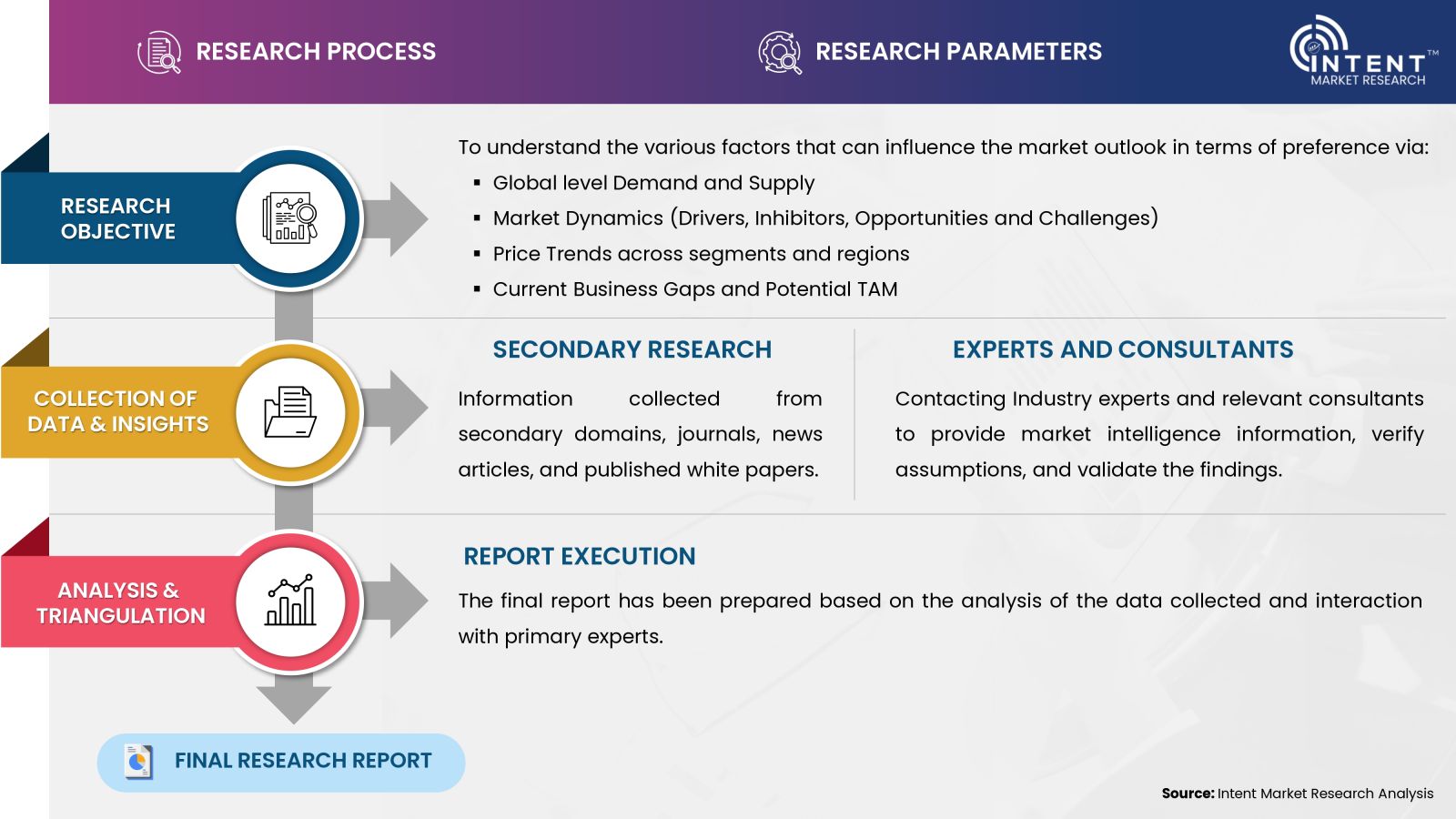
- Secondary Research Approach: During the initial phase of the research process, we acquire and accumulate extensive data continuously. This data is carefully filtered and validated through a variety of secondary sources.
- Primary Research Approach: Following the consolidation of data gathered through secondary research, we initiate a validation process to verify all the market numbers, and assumptions and validate the findings by engaging with subject matter experts.
Data Collection, Analysis and Interpretation:
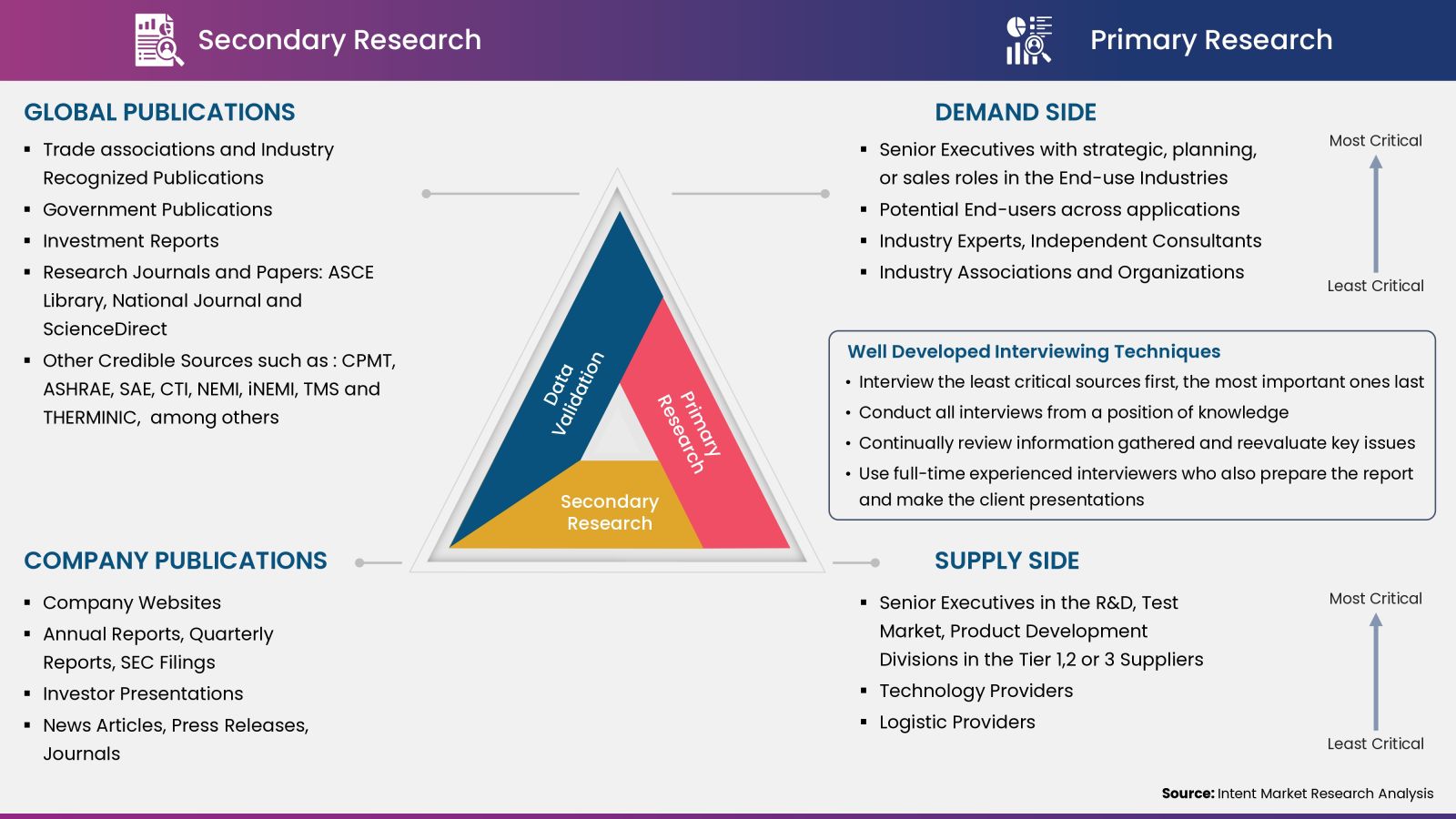
Research Methodology
Our market research methodology utilizes both top-down and bottom-up approaches to segment and estimate quantitative aspects of the market. We also employ multi-perspective analysis, examining the market from distinct viewpoints.
